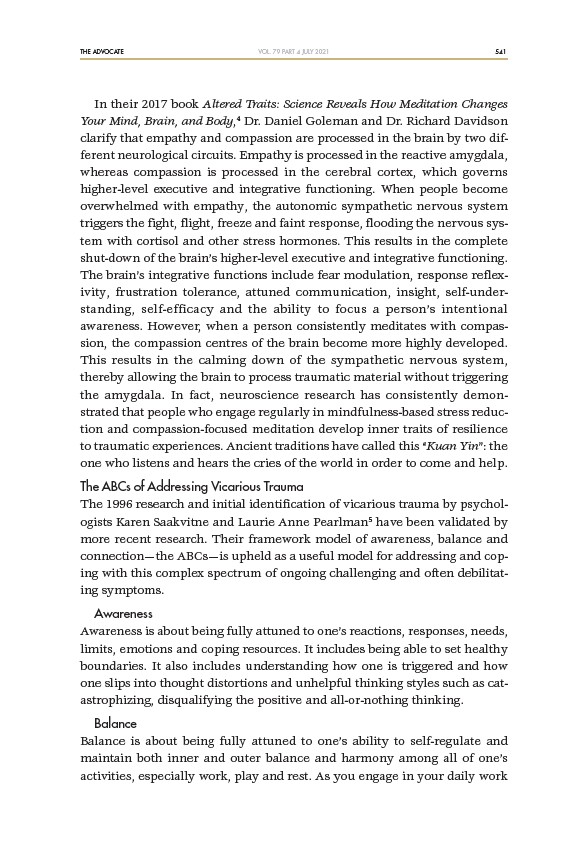
THE ADVOCATE 541
VOL. 79 PART 4 JULY 2021
In their 2017 book Altered Traits: Science Reveals How Meditation Changes
Your Mind, Brain, and Body,4 Dr. Daniel Goleman and Dr. Richard Davidson
clarify that empathy and compassion are processed in the brain by two different
neurological circuits. Empathy is processed in the reactive amygdala,
whereas compassion is processed in the cerebral cortex, which governs
higher-level executive and integrative functioning. When people become
overwhelmed with empathy, the autonomic sympathetic nervous system
triggers the fight, flight, freeze and faint response, flooding the nervous system
with cortisol and other stress hormones. This results in the complete
shut-down of the brain’s higher-level executive and integrative functioning.
The brain’s integrative functions include fear modulation, response reflexivity,
frustration tolerance, attuned communication, insight, self-understanding,
self-efficacy and the ability to focus a person’s intentional
awareness. However, when a person consistently meditates with compassion,
the compassion centres of the brain become more highly developed.
This results in the calming down of the sympathetic nervous system,
thereby allowing the brain to process traumatic material without triggering
the amygdala. In fact, neuroscience research has consistently demonstrated
that people who engage regularly in mindfulness-based stress reduction
and compassion-focused meditation develop inner traits of resilience
to traumatic experiences. Ancient traditions have called this “Kuan Yin”: the
one who listens and hears the cries of the world in order to come and help.
The ABCs of Addressing Vicarious Trauma
The 1996 research and initial identification of vicarious trauma by psychologists
Karen Saakvitne and Laurie Anne Pearlman5 have been validated by
more recent research. Their framework model of awareness, balance and
connection—the ABCs—is upheld as a useful model for addressing and coping
with this complex spectrum of ongoing challenging and often debilitating
symptoms.
Awareness
Awareness is about being fully attuned to one’s reactions, responses, needs,
limits, emotions and coping resources. It includes being able to set healthy
boundaries. It also includes understanding how one is triggered and how
one slips into thought distortions and unhelpful thinking styles such as catastrophizing,
disqualifying the positive and all-or-nothing thinking.
Balance
Balance is about being fully attuned to one’s ability to self-regulate and
maintain both inner and outer balance and harmony among all of one’s
activities, especially work, play and rest. As you engage in your daily work